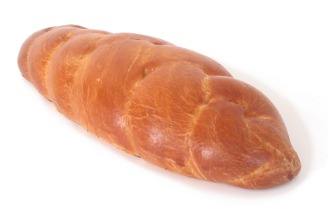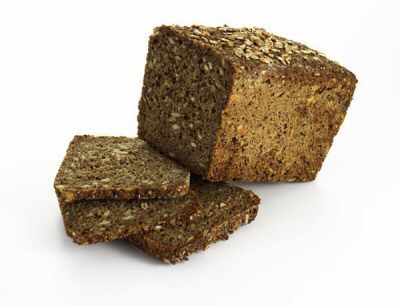
Fresh Baked Bread
The Insight Meditation Society in Barre, Massachusetts, occupies the site of a former Catholic retreat center. The meditation hall was once a chapel, and although the founders of IMS removed most of the stained glass windows long ago, they left two of the windows in the vestibule (now used for walking meditation) intact. One of the windows depicts Christ in the wilderness, crying as if in desperation for the Lord. The other, directly across the room, depicts a scene from the Last Supper, with Christ distributing the bread of the meal, and, as every Catholic would know, initiating the first communion rite. One of the disciples, probably John, is looking on with rapt attention, and a subtle smile on his face as he prepares to receive the flesh of God. There is love in his eyes, and he is resting on Jesus's shoulder. It is an exquisitely tender scene which can be appreciated by Christians, Buddhists, and, I hope, Jews alike.
Toward the end of a retreat I was sitting at IMS, someone stuck a yellow post-it note next to John's face, with the words "Fresh Baked Bread" written on it, and a small drawing of a heart. It was funny, if a bit impudent, and it underscored the gap between the ornate mythology of Jesus and the clean, no-bullshit air of vipassana. The bread, after all, was symbolically contentious: I thought of all those raging Christian debates about transubstantiation, consubstantiation, and the ultimate significance of communion; about whether soda crackers really did turn into meat (to use Kurt Vonnegut's paraphrase of the ritual) and whether, as a result, Christians were engaging in ritual cannibalism. Maybe it was a metaphor; maybe it was a figure of speech; or maybe it was magic. I remembered how Jesus was re-signifying the symbols of the Passover Seder, and how the Talmudic rabbis would attempt to steal them back. All these stories in the air, contrasted with the simple delight of fresh baked bread. I came to see the note less as a satire on the window than as a complement to it -- an alternative reading. To a Catholic, the significance of the scene is its mythic and theological context. But to a Buddhist, it's about fresh baked bread.
And not because bread is insignificant. On the contrary, I remember reading at some point a Buddhist-Christian reading of the Last Supper, which translated it in the same way as the Post-It joke, although in more reverent terms. The writer -- I can't remember who it was -- interpreted Jesus's words "This bread is my body" as meaning, "I am God, just as you are, just as this bread is. Understand that there is only the One; only Being; only God. This bread, this bread is my body. This blood, this blood is my wine. If you can eat this bread with total attention to it, it will taste to you as the flesh of the Divine. And so it is -- there is no distinction, really, between it and Me."
About a year ago, in this magazine, I wrote an essay with a similar trajectory. It became a bit controversial -- at one well-known Jewish learning conference, a disgusted reader took all the copies of Zeek in the bookstore and threw them on the floor, demanding that the store stop selling such trash. Maybe it was just that the title was "How I Finally Came to Accept Christ in My Heart." Or maybe it was that what the essay discussed -- my own Jewish fear of Jesus -- is still alive and well in the Jewish community. Really, though, all I was trying to do was understand Jesus on his own terms, and on the terms of nondual theology. My claim was that if Christ were a fully enlightened being, then he knows that his separate self -- the small mind, the ego, the yetzer hara of Joshua son of Joseph -- is not separate at all. And then Jesus's God-language makes a lot of sense, because, without the illusion of separation, who else are we, anyway? There's all this activity, all this knowing, but no separate self is really doing or knowing anything; we're just temporary agglomerations of the same atoms that once were inside a star. Our brains produce the useful illusion of separate consciousness, but we're not separate at all; we're just earth, air, fire, and water -- or subatomic particles, in more recent science -- soon to be re-scattered and re-formed. Moreover, since the enlightenment of Christ is really a shedding of the separate identity of Jesus, it makes more sense to speak of Jesus as being an incarnation of God than to speak of God-consciousness as something Jesus "attained." Enlightenment is something that happens -- not something you get.
 So maybe there is a convergence between the communion and the dharma. Communion is like a mindfulness practice, and a contemplation. Mindfulness practice insofar as the attention is meant to be wholly focused on this moment -- all the bells and whistles, all the ceremony, really makes it seem Important, and so the mind, if it takes the ritual seriously, is far more attentive than usual. And contemplation insofar as communion invites the consideration of an important theological idea: that every cracker, every drop of wine, is really the flesh and blood of God. Fresh baked bread is God, and communion makes that known experientially and intellectually.
So maybe there is a convergence between the communion and the dharma. Communion is like a mindfulness practice, and a contemplation. Mindfulness practice insofar as the attention is meant to be wholly focused on this moment -- all the bells and whistles, all the ceremony, really makes it seem Important, and so the mind, if it takes the ritual seriously, is far more attentive than usual. And contemplation insofar as communion invites the consideration of an important theological idea: that every cracker, every drop of wine, is really the flesh and blood of God. Fresh baked bread is God, and communion makes that known experientially and intellectually.
Still, there is a fundamental difference between the Jewish and Christian move, , and the Buddhist one. In Judaism, we eat fresh baked bread all the time: challah, matza, you name it. Bread is the halachic requirement for a religious "feast," and, of course, the rabbis carefully measure out exactly how much you have to eat. Yet despite all the focus on the materiality of bread, its use in ritual frequently ignores how delightful fresh baked bread is, in favor of some theological, symbolic, or legal construct. This is the critical move of most Western religion, whether "spiritual" or not: away from the thing itself, and toward a web of significance.
In the mystical, Kabbalistic model, the bread is significant because of its specific symbolic meanings: two loaves representing masculine and feminine, the numerical equivalents of "matza," and so on. Ideas about the thing, not the thing itself. Of course, the Kabbalists themselves would dispute that "the thing itself" is its true reality; for them, the word "matza" is more real than the actual cracker. But I wonder if I agree.
In the halachic model, the move takes place in the realm of law. For example, Rabbi Joseph Soloveitchik, in Halakhic Man, describes the importance of a sunset inhering in its status as a legal signifier:
| When halakhic man looks to the western horizon and sees the fading rays of the setting sun or to the eastern horizon and sees the fast light of dawn and the glowing rays of the rising sun, he knows that this sunset or sunrise imposes upon him anew obligations and commandments. |
Here, too: ideas about the thing, not the thing itself. Personally, my relationship to this bit of Soloveitchik has evolved, from an initial horror to a deep appreciation of halacha's groundedness: Hasidism and Romanticism take us to inspiration, and halacha brings us back; every act is capable of sanctification, regardless of how we feel about it. And probably back to a bit of horror.



The Jerusalem Same-Sex Attraction Group
Phil S. Stein
The Second Coming of Yeshayahu Leibowitz
Avi Steinberg
An Account of the Saltscape
Joshua Cohen
Fresh Baked Bread
Jay Michaelson
Out of the Depths
Lorna Knowles Blake
Lore
Adam Lavitt
Archive
Our 790 Back Pages
Zeek in Print
Fall 2005 issue out now!
About Zeek
Mailing List
Contact Us
Subscribe
Tech Support
Links
From previous issues:
Out of Bounds
Two Incidents at the Cafe Kamienica
Sitting on an aeroplane, while Grandma Dies
Angela Himsel
Gordon Haber
Nigel Savage